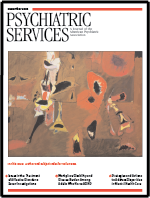Racial Differences in the Treatment of Veterans With Bipolar Disorder
Abstract
OBJECTIVES: The authors examined whether African Americans, compared with whites, received guideline-concordant care for bipolar I disorder. METHODS: A retrospective analysis was conducted of data for patients who received a diagnosis of bipolar I disorder in fiscal year 2001 and received care in facilities in the Department of Veterans Affairs (VA) mid-Atlantic region. Indicators of guideline-concordant care were based on prescription data and data on utilization of inpatient and outpatient services from VA databases. RESULTS: A total of 2,316 patients with a diagnosis of bipolar I disorder were identified. Their mean age was 52 years; 9.4 percent (N=218) were women, and 13.1 percent (N=303) were African American. Overall, mood stabilizers were prescribed for 74.6 percent (N=1,728) of the patients; 67.1 percent (N=1,554) had an outpatient mental health visit within 90 days after the index diagnosis, and 54.3 percent (N=1,258) had an outpatient visit within 30 days after discharge from a psychiatric hospitalization. Multivariate logistic regression analyses with adjustment for sociodemographic and facility factors revealed that African Americans were less likely than whites to have an outpatient follow-up visit within 90 days after the index diagnosis. Race was not associated with receipt of mood stabilizers or use of outpatient services after a hospital discharge. CONCLUSIONS: Although a majority of patients received guideline-concordant care for bipolar disorder, potential gaps in continuity of outpatient care may exist for African-American patients.



